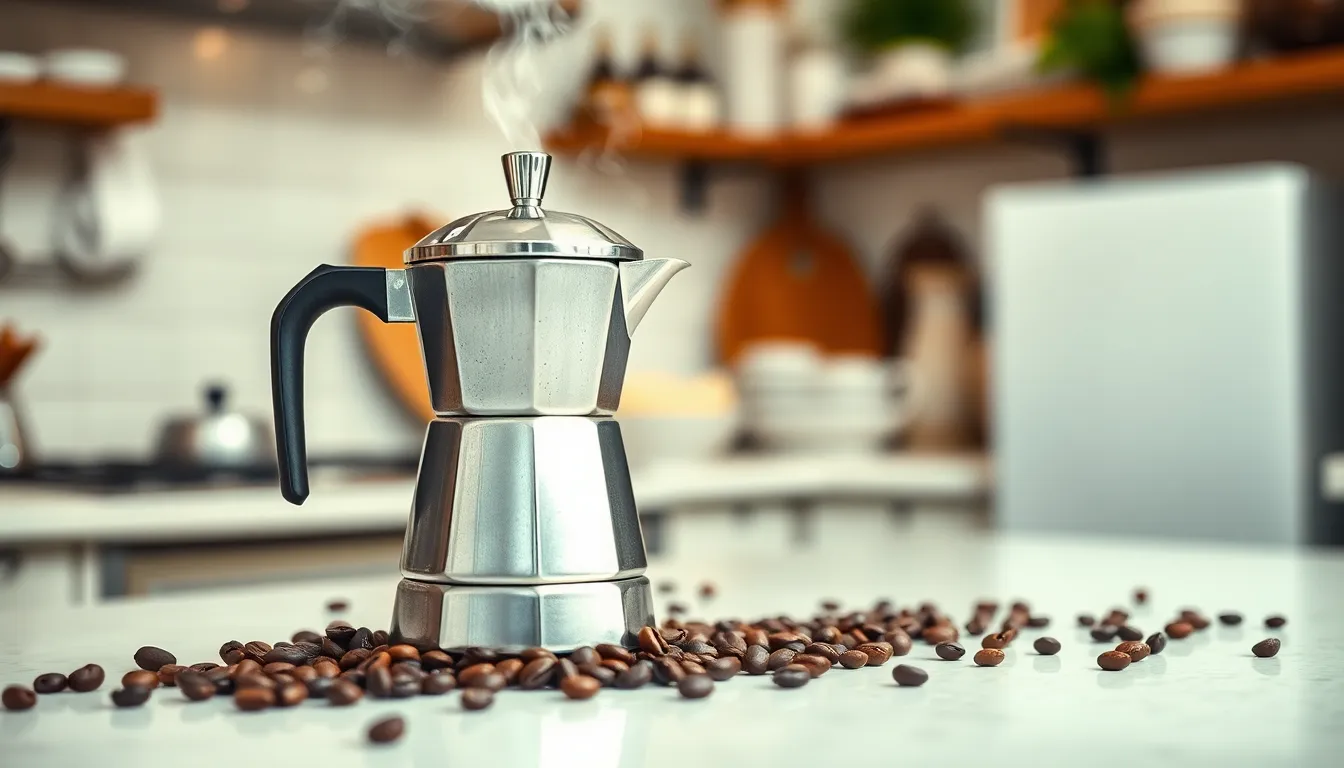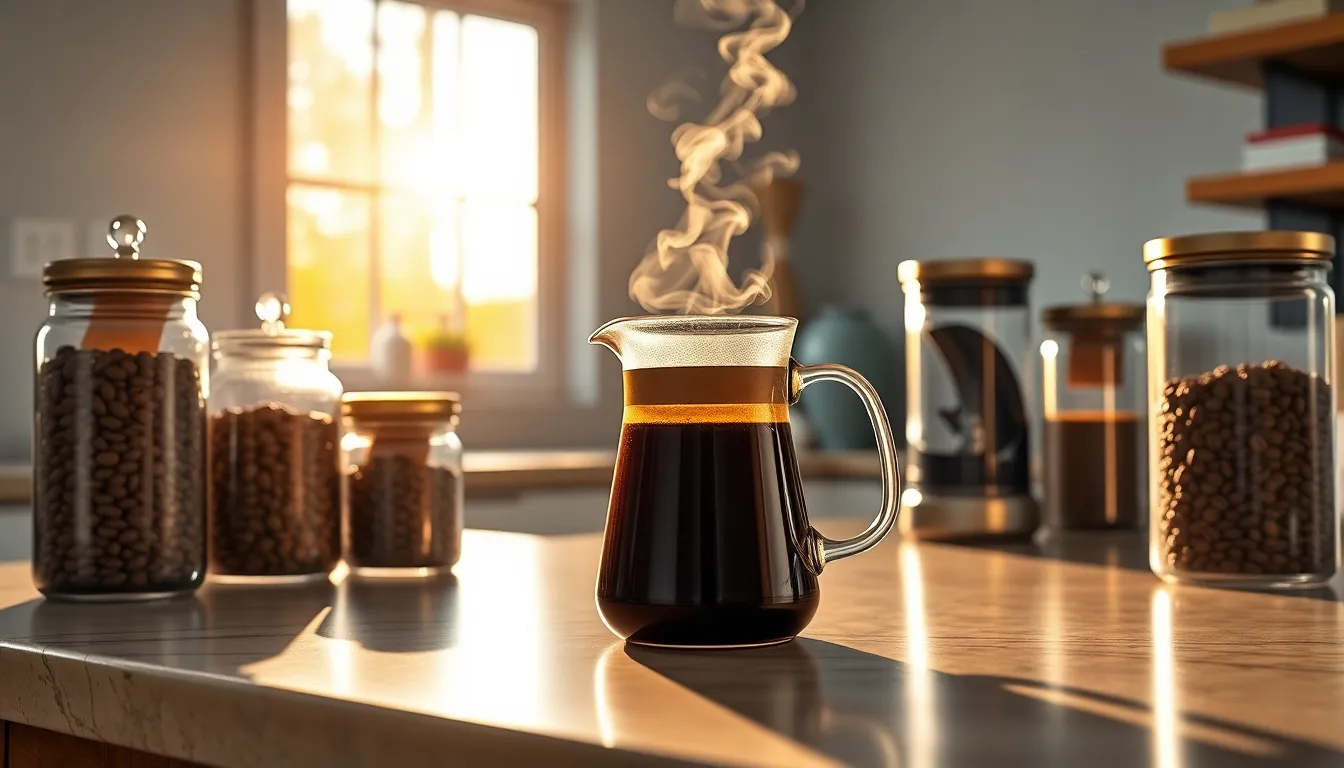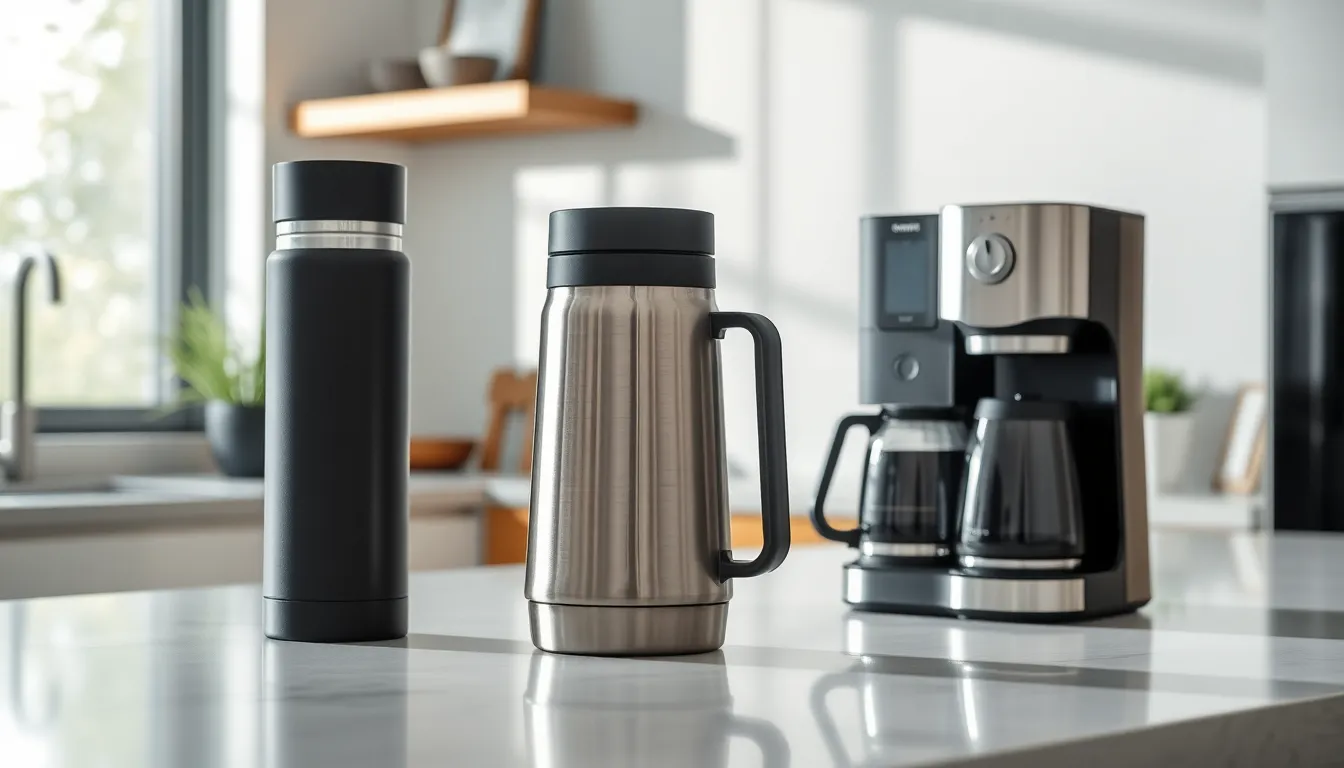Ever wondered how long your coffee can sit in the pot before it’s no longer worth drinking? That perfect morning brew gradually transforms as it sits, affecting both flavor and safety in ways you might not expect.
Whether you’re a busy professional who forgot about your coffee or someone who likes to savor it throughout the day, knowing the shelf life of brewed coffee matters. The answer isn’t simply about taste preferences—it involves chemical changes that occur once those aromatic beans meet hot water. Let’s explore what happens to your coffee when it sits and how to determine when it’s time to brew a fresh pot instead.
The Freshness Timeline: How Long Can Coffee Sit in the Pot
Brewed coffee begins to lose its optimal flavor within 30 minutes of brewing. After this initial window, oxidation and cooling start affecting the complex flavor compounds that make your coffee enjoyable. Coffee left sitting for 1-2 hours maintains acceptable drinking quality but noticeably loses its aromatic qualities and distinctive flavor notes.
At the 4-hour mark, your coffee develops a more bitter taste as oils break down and acids become more pronounced. Coffee that sits for 8 hours (a typical workday) is safe to drink but tastes significantly flat and acidic compared to a fresh brew. Beyond 12 hours, while technically safe to consume if kept at room temperature, the coffee develops an unpleasant sour taste that most coffee enthusiasts find unacceptable.
Hot-plate warming extends drinking quality slightly but accelerates flavor degradation through continued heat exposure. Electric coffee pots typically maintain temperatures between 170-185°F, which prevents bacterial growth but continues to “cook” your coffee, creating increasingly bitter compounds. Coffee in thermal carafes retains acceptable flavor for 2-4 hours longer than coffee kept on warming plates due to stable temperatures that slow oxidation without adding bitterness.
One regular customer, James, told me he discovered his perfect coffee window was under 90 minutes after switching to a thermal carafe. “The difference was night and day—I stopped wondering why my afternoon coffee always tasted burnt,” he explained.
The Science Behind Coffee Degradation

Understanding the chemical processes behind coffee degradation explains why your brew doesn’t taste the same after sitting in the pot. Two primary factors—heat and oxidation—work simultaneously to break down the complex flavors that make freshly brewed coffee so enjoyable.
Heat and Oxidation Effects
Heat in your coffee pot continues to “cook” your brew long after the brewing process ends. This ongoing heat exposure alters the chemical structure of coffee compounds, intensifying bitterness and sourness while diminishing the pleasant aromatic notes. The volatile compounds responsible for coffee’s desirable flavors break down faster at higher temperatures, which is why coffee left on a hot plate deteriorates more quickly than coffee stored in a thermal container.
Oxygen exposure creates another important problem for your coffee. The oxidation process begins immediately after brewing, causing coffee to develop a stale or “flat” taste. Hot coffee oxidizes more rapidly than room temperature coffee, and reheating an old pot only accelerates this degradation further. Storing coffee in airtight, insulated containers slows oxidation but can’t prevent it entirely—your coffee’s flavor compounds will still break down over time.
Changes in Flavor Profile Over Time
Coffee contains a complex mixture of volatile oils and compounds immediately after brewing that provide its fresh aroma and distinctive taste profile. Within 30 minutes, these compounds start degrading noticeably, causing the flavor to flatten and develop unpleasant bitter or sour notes. After 4-6 hours at room temperature, your coffee becomes stale and generally unpleasant to drink.
The transformation follows a predictable pattern: the bright, vibrant notes disappear first, followed by the mid-range flavors, leaving behind only the bitter compounds that dominate old coffee. The aromatic profile changes dramatically too—from the rich, enticing scent of fresh coffee to the flat, sometimes sour smell of coffee that’s been sitting too long.
Optimal Drinking Windows for Different Brewing Methods

Each coffee brewing method creates a unique flavor profile that degrades at different rates when left sitting. Understanding these timeframes helps you enjoy your coffee at its peak flavor and avoid wasting perfectly good brew.
Drip Coffee Machines
Drip coffee maintains its optimal flavor for 4-6 hours when kept on a warming plate. After this window, the natural oils in the coffee begin to deteriorate, resulting in a stale or bitter taste due to over-extraction from continuous heat exposure. Many coffee enthusiasts transfer their drip-brewed coffee to a thermal carafe to preserve its flavor longer without burning it on a hot plate.
Storing your brewed coffee in a sealed container in the refrigerator extends its drinkability for up to 3-4 days, though the flavor quality gradually diminishes. This approach works particularly well if you’re planning to make iced coffee later or don’t mind a slight change in taste profile.
French Press and Pour-Over
French press and pour-over coffee should be consumed within 30-60 minutes for the best flavor experience. These methods typically produce smaller batches without heat retention elements, causing the coffee’s natural oils and aromas to degrade rapidly when exposed to air.
Transferring your French press or pour-over coffee to an airtight thermal mug immediately after brewing effectively slows flavor degradation. This simple step helps maintain both warmth and taste without overcooking the delicate flavor compounds that make these brewing methods so popular among coffee connoisseurs.
While coffee remains safe to drink for much longer periods, the rich flavors and healthful antioxidants significantly diminish beyond these recommended timeframes. Properly stored coffee prevents mold development, which can occur if coffee sits out for a week or more.
Health and Safety Considerations

While flavor degradation is the primary concern with coffee that sits in a pot, health and safety issues also merit consideration. Brewed coffee undergoes both bacterial changes and chemical transformations that can affect not just taste but potentially your wellbeing.
Bacterial Growth Concerns
Brewed coffee left at room temperature becomes a potential medium for bacterial growth after several hours. Its natural acidity initially creates an environment somewhat inhospitable to bacteria, but this protection diminishes as the coffee cools. Airborne bacteria and microorganisms can contaminate your coffee, particularly in uncovered pots or those frequently opened throughout the day. Coffee sitting out for more than a day accumulates important bacterial populations, though immediate health risks from shorter periods remain relatively low.
Mold development becomes a serious concern for coffee left at room temperature for about a week, making it both unpleasant and potentially harmful to consume. Regular cleaning of your coffee pot prevents bacterial buildup that could compromise future brews. Refrigerating your brewed coffee in a sealed container extends its safety window to 3-4 days, though you’ll need to reheat it to your preferred drinking temperature.
Acidity Changes
Coffee’s natural oils begin deteriorating approximately 4-5 hours after brewing, resulting in noticeable flavor degradation. This breakdown transforms once-bright flavors into bitter or stale notes that most coffee drinkers find unpleasant. Acidity levels in your coffee decrease over time, especially when maintained on a heat source, which fundamentally alters its taste profile.
Coffee kept on a warming plate for extended periods loses its delicate acidity completely, developing increasingly bitter and unpleasant flavors. Interestingly, caffeine remains stable even in old coffee, so while your day-old brew might taste terrible, it still delivers the same energy boost. These chemical changes primarily affect enjoyment rather than safety, though they signal the beginning of the coffee’s overall decline.
Extending Your Coffee’s Lifespan

Coffee’s flavor deteriorates quickly, but several effective methods can extend its drinkable period beyond the initial 20-minute freshness window. By employing proper storage techniques and understanding heating options, you’ll maximize both enjoyment and value from every pot you brew.
Proper Storage Answers
Storing brewed coffee correctly dramatically extends its shelf life and preserves its flavor profile. Whole beans maintain peak freshness for 6-12 months when kept in airtight containers away from heat and light sources. Once opened, consume these beans within 2-4 weeks for optimal flavor, and grind them immediately before brewing to capture their full aromatic potential.
Ground coffee retains its best qualities for 1-2 weeks after opening when stored in airtight containers protected from light and heat. Unopened packages typically last 3-5 months before quality diminishes. Transferring freshly brewed coffee from the hot plate to an insulated airpot or thermal carafe prevents exposure to oxygen—coffee’s primary freshness enemy—while maintaining temperature without continued heating that causes bitterness.
Cold brew coffee offers extended longevity compared to hot-brewed varieties, lasting 7-14 days when properly sealed and refrigerated. Black coffee stored in the refrigerator remains drinkable for 3-4 days, though flavor quality gradually declines. Adding dairy products shortens this window significantly to 1-2 days refrigerated or just 1-2 hours at room temperature.
Reheating vs. Making a Fresh Pot
Reheating coffee that has been sitting for hours typically produces disappointing results due to important oxidation and breakdown of flavor compounds. The reheating process itself further degrades remaining flavor components, often intensifying bitterness and eliminating any nuanced notes that might have survived.
Brewing a fresh pot consistently delivers superior taste compared to reheating old coffee. Chemical changes occurring during the sitting period permanently alter coffee’s flavor profile, creating changes that can’t be reversed through reheating. Many coffee enthusiasts find that even carefully reheated coffee lacks the vibrant character and aromatic complexity of a fresh brew.
If you must reheat coffee, gentle warming methods produce better results than aggressive reheating. Microwaving briefly at medium power or warming slowly on low stovetop heat helps minimize additional flavor deterioration. Avoid bringing reheated coffee to a boil, as this accelerates the breakdown of remaining flavor compounds and increases bitterness.
Coffee Preservation Tools and Technologies

Vacuum-sealed containers offer effective protection against coffee’s primary enemies: oxygen, light, and moisture. These specialized vessels create an airtight environment that significantly slows the oxidation process, preserving both flavor and aroma for extended periods. High-quality vacuum containers can extend the shelf life of brewed coffee by limiting exposure to air that typically accelerates degradation.
Thermal carafes represent one of the most practical innovations for maintaining coffee freshness. These double-walled, insulated containers keep coffee hot for 4-6 hours without requiring a heating element, preventing the “cooking” effect that makes coffee bitter on traditional warming plates. Many coffee enthusiasts find that thermal carafes preserve delicate flavor notes that would otherwise disappear within an hour in conventional pots.
Refrigeration technology provides another viable option for extending coffee’s drinkability, particularly for cold brew varieties. Properly sealed and refrigerated cold brew coffee remains flavorful for up to 14 days, maintaining its low acidity profile throughout this period. The key lies in using airtight containers that prevent absorption of other food odors and flavors from the refrigerator.
Airtight storage systems with one-way valves offer specialized protection for coffee beans and grounds. These containers allow carbon dioxide to escape (a natural byproduct of fresh coffee) while preventing oxygen from entering, creating an optimal storage environment. Though primarily designed for unbrewed coffee, the same principle applies to storing cooled brewed coffee when you need to preserve it for later consumption.
Smart coffee makers with programmable freshness timers have emerged as technological answers to the staling problem. These devices automatically shut off after preset intervals (typically 30 minutes to 2 hours) to prevent coffee from sitting too long on warming plates. Some advanced models even incorporate vacuum-sealing technology directly into their carafes, combining heat retention with oxidation prevention.
Nitrogen-flushing technology, borrowed from create beer preservation methods, has begun appearing in premium coffee shops and specialized home brewing systems. By replacing oxygen with nitrogen in storage containers, this technique dramatically slows the degradation process, potentially extending brewed coffee’s flavor stability by several days compared to conventional storage methods.
Conclusion
Enjoying coffee at its peak flavor is all about timing. Fresh-brewed coffee gives you that perfect balance of aroma and taste within the first 30-60 minutes after brewing.
After sitting for several hours your coffee remains safe to drink but undergoes important flavor changes due to oxidation and continued heat exposure.
Your brewing method storage solution and personal taste preferences all play important roles in determining your ideal coffee window. Whether you’re using a thermal carafe investing in preservation tools or simply brewing smaller batches you can make informed decisions to enjoy every cup at its best.
Remember that while day-old coffee might still give you a caffeine boost it won’t deliver the nuanced flavors that make coffee such a beloved beverage.
Frequently Asked Questions
How long does brewed coffee stay fresh?
Brewed coffee begins losing optimal flavor within 30 minutes. After 1-2 hours, you’ll notice significant taste degradation. By 4 hours, bitterness increases, and after 8 hours, it tastes flat and acidic though still safe to drink. After 12 hours, coffee develops an unpleasant sour taste. For the best experience, consume coffee within the first hour after brewing.
Is day-old coffee safe to drink?
Yes, day-old coffee is generally safe to drink, though it won’t taste good. Coffee left at room temperature for several hours can become a medium for bacterial growth, with risks increasing significantly after 24 hours. While the caffeine remains stable, the flavor will be noticeably deteriorated. Refrigerated brewed coffee in a sealed container remains safe for 3-4 days.
Does coffee lose caffeine over time?
No, caffeine remains stable in brewed coffee even after several days. While the flavor compounds deteriorate significantly after a few hours, the caffeine content stays virtually unchanged. This means even day-old coffee can still provide an energy boost, though you’ll sacrifice taste quality. The primary changes over time affect flavor, not caffeine potency.
What’s the best way to store brewed coffee?
For hot coffee, transfer it to a thermal carafe immediately after brewing to maintain quality for 2-4 hours longer than a glass pot. For longer storage, cool completely and store in an airtight container in the refrigerator for up to 3-4 days. Cold brew coffee lasts even longer when sealed and refrigerated, remaining drinkable for 7-14 days.
Can you reheat brewed coffee?
You can reheat coffee, but it typically results in disappointing flavor. Reheating accelerates oxidation and breakdown of flavor compounds, often creating increased bitterness. If necessary, use gentle warming methods like low heat on a stovetop or microwave at 50% power with short intervals. For the best taste experience, brewing a fresh pot is always recommended.
How do different brewing methods affect coffee’s shelf life?
Different brewing methods create varied shelf lives. Drip coffee maintains decent flavor for 4-6 hours on a warming plate. French press and pour-over coffee degrade more rapidly, best consumed within 30-60 minutes due to greater air exposure. Cold brew lasts longest, staying fresh for 7-14 days when refrigerated. The brewing method’s filter type and extraction process significantly impact how quickly flavors deteriorate.
What causes coffee to go bad?
Two primary factors cause coffee degradation: heat and oxidation. Heat continues to “cook” the coffee, altering its chemical structure and intensifying bitterness. Oxidation occurs when coffee compounds react with oxygen, creating a stale taste. These processes cause vibrant flavor notes to disappear first, leaving behind bitter compounds. Natural oils also begin to deteriorate after 4-5 hours, further affecting flavor quality.
Do thermal carafes really help preserve coffee flavor?
Yes, thermal carafes significantly help preserve coffee flavor. They keep coffee hot without additional heat application, which prevents the “cooking” effect that causes bitterness. Quality thermal carafes can maintain good flavor for 2-4 hours longer than glass pots. They also limit oxygen exposure, reducing oxidation. For best results, pre-heat the carafe with hot water before adding freshly brewed coffee.

